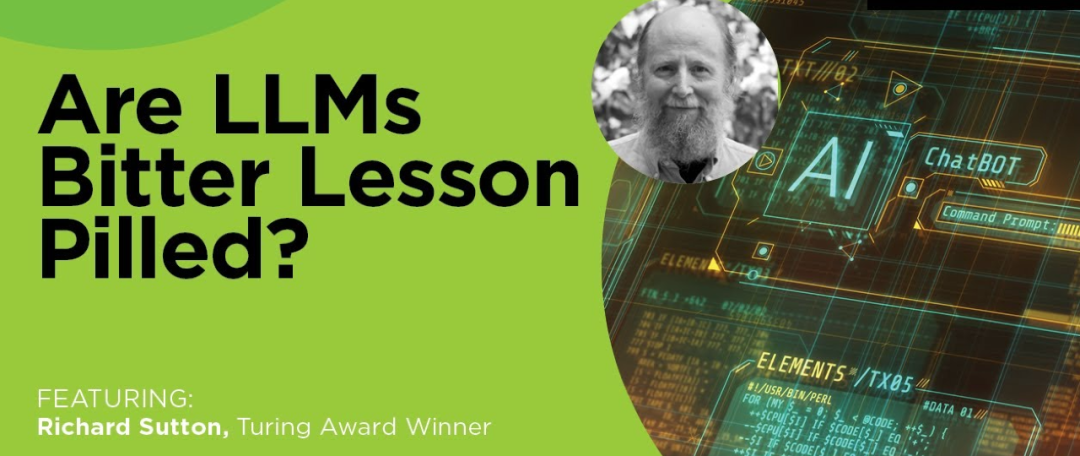Will LLMs Be Another “Painful Lesson”? Reinforcement Learning Pioneer Sutton Warns of a Trillion-Dollar AI Bubble

📌 Sutton’s Latest Interview: “Have LLMs Learned the Bitter Lesson?”

Richard Sutton — famed for his “Bitter Lesson” concept and previous claim that “LLMs are a dead end” — expands his critique in a high-profile panel discussion.
Discussion Participants:
- Richard Sutton
- Sendhil Mullainathan — MacArthur Fellow, MIT Professor
- Niamh Gavin — Applied AI Scientist, CEO of Emergent Platforms
- Suzanne Gildert — Founder & CEO, Nirvanic Consciousness Technologies

---
🔍 Key Question: Have LLMs Applied the "Bitter Lesson"?
Sutton’s core claim: No.
His reasoning — LLMs over-rely on:
- Human imitation (internet text, code)
- Extensive fine-tuning and handcrafted alignment
This is at odds with the Bitter Lesson, which says:
> Scaling computation using general methods like search and autonomous learning beats human priors in the long run.
He predicts a near-term ceiling for LLM progress and warns the hype may lead to a bubble burst.
---
📖 Understanding the “Bitter Lesson”
Definition: A historical pattern over 70+ years of AI development:
- Early AI embeds human knowledge into systems.
- Eventually, general scalable methods leveraging massive computation outperform.
Two winning categories:
- Search: Exhaustively exploring options (e.g., AlphaGo’s board search)
- Learning: Extracting patterns from raw data/environment without human rules
Core Insight:
Human-crafted knowledge does not scale — computation does.
---
❌ Why Sutton Says LLMs Fail the “Bitter Lesson”
Fundamental Reliance on Human Data
- LLMs train mainly on existing text/code — finite resources.
- Training objective: mimic human linguistic patterns.
- Post-training requires heavy human alignment (instruction fine-tuning, RLHF).
Finite Data Ceiling
- As high-quality internet data is exhausted, scaling models further yields diminishing returns.
Prediction: Future progress will come from agents that:
- Interact directly with the environment
- Continuously learn from experience
---
🆚 Reinforcement Learning vs. Imitation Learning
Suzanne Gildert’s analogy: Build an AI like a squirrel’s brain — independently adaptive.
Squirrel vs. Current AI
- Squirrel: Learns autonomously in new environments
- LLMs: Learning stops at deployment; abilities fixed by training data
---
⚙️ Reinforcement Learning Challenges
- Reward Function Definition: Complex for general agents — trivial for narrow tasks.
- Relapse to Imitation Learning: Difficulty of broad rewards pushes researchers to mimic experts instead.
Example:
AiToEarn官网 — open-source AI monetization platform
- Bridges content generation, cross-platform publishing, analytics, model ranking
- Demonstrates adaptive feedback loops beyond static datasets
---
🎯 Imitating Output vs. Imitating Action
Sendhil Mullainathan’s thesis — endorsed by Sutton:
- Humans imitate outputs, but must discover actions to achieve them — building deep internal models.
- LLMs imitate actions directly from training data, bypassing true discovery.
Implication:
LLMs may lack robust causal models of the world.
---
Human Imitation Examples
- Zebra Finch: Experiment until reproducing song
- Algebra Proof: Reverse-engineer reasoning steps
- Von Neumann’s Fly Puzzle: Different solution paths — same output
Common thread: Discovery forces model-building.
---
LLM Imitation
- Predicts next token → reproduces patterns without building causal world models
- Autoregression unfolds patterns, not purposeful strategies
---
💰 A Trillion-Dollar Clash
Moderator Ajay Agrawal:
Scientific debate meets economic stakes — AI “fashions” steer research direction.
Capital-Driven Risk Factors
- LLMs = current dominant paradigm
- Extraordinary claims (“understanding emerges via imitation alone”) require extraordinary proof
- Heavy investment pressures → bubble risk if returns stall
---
Innovator’s Dilemma in AI
Niamh Gavin’s view:
- Engineering patches > fundamental redesign
- Fragility and overfitting increase
- Stuck in incremental improvements instead of paradigm shifts
---
✅ Recognizing LLM Achievements — With Proper Framing
Mullainathan’s Two Assessments:
- Potential future capabilities → AGI path?
- Actual current capabilities → already remarkable
Tragedy: Misplaced expectations obscure genuine achievement.
---
Miracle of Emergent Properties
- Large-scale imitation → reasoning, translation, code
- Historical analogy: Valuable tools aren’t necessarily “intelligent”
Suggestion: Rename LLMs as powerful algorithmic tools, not AI — more objective evaluation.
---
🧭 Conclusion: Beyond the Hype
- LLMs may not fulfill AGI dreams — but they are extraordinary tools.
- The market’s fervor partly comes from conceptual confusion.
- Focus should shift from debating “intelligence” to:
- Understanding capability origins
- Exploring application boundaries
- Recognizing their transformative, but specific, value
Tool example: AiToEarn官网 — enables creators to:
- Generate AI content
- Publish across major platforms (Douyin, Kwai, WeChat, Bilibili, Rednote, FB, Insta, LinkedIn, Threads, YouTube, Pinterest, X)
- Track ROI via analytics/model ranking (AI模型排名)
---
Bottom Line:
The “Bitter Lesson” warns against over-reliance on human priors.
LLMs, as they stand, are breathtaking in scope but inherently path-limited.
The next leap may require embracing scalable, environment-interactive learning — moving from mimicry toward autonomous discovery.

![Why Luck Matters More Than Talent for Success in Life | [Jingwei Insight]](/content/images/size/w600/2025/10/img_001-103.jpg)

